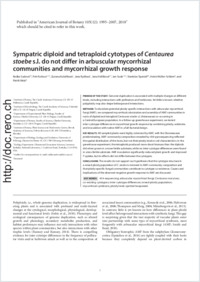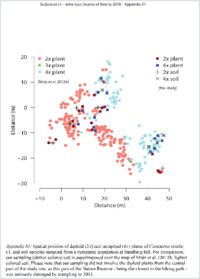Sympatric diploid and tetraploid cytotypes of Centaurea stoebe s.l. do not differ in arbuscular mycorrhizal communities and mycorrhizal growth response
- Sudová, Radka Institute of Botany, The Czech Academy of Sciences, Průhonice, Czech Republic -
- Kohout, Petr Institute of Botany, The Czech Academy of Sciences, Průhonice, Czech Republic - Institute of Microbiology, The Czech Academy of Sciences, Vídeňská, Prague, Czech Republic - Department of Experimental Plant Biology, Faculty of Science, Charles University, Prague, Czech Republic
- Kolaříková, Zuzana Institute of Botany, The Czech Academy of Sciences, Průhonice, Czech Republic
- Rydlová, Jana Institute of Botany, The Czech Academy of Sciences, Průhonice, Czech Republic
- Voříšková, Jana Institute of Microbiology, The Czech Academy of Sciences, Vídeňská, Prague, Czech Republic - Ecology Department, Climate and Ecosystem Sciences, Lawrence Berkeley National Laboratory, USA
- Suda, Jan Institute of Botany, The Czech Academy of Sciences, Průhonice, Czech Republic - Department of Botany, Faculty of Science, Charles University, Prague, Czech Republic
- Španiel, Stanislav Department of Botany, Faculty of Science, Charles University, Prague, Czech Republic - Institute of Botany, Plant Science and Biodiversity Centre, Slovak Academy of Sciences, Bratislava, Slovakia
- Müller-Schärer, Heinz Department of Biology, Ecology and Evolution, University of Fribourg, Switzerland
- Mráz, Patrik Department of Botany, Faculty of Science, Charles University, Prague, Czech Republic
-
2018
Published in:
- American Journal of Botany. - 2018, vol. 105, no. 12, p. 1995–2007
English
Genome duplication is associated with multiple changes at different levels, including interactions with pollinators and herbivores. Yet little is known whether polyploidy may also shape belowground interactions.Methods: To elucidate potential ploidy‐specific interactions with arbuscular mycorrhizal fungi (AMF), we compared mycorrhizal colonization and assembly of AMF communities in roots of diploid and tetraploid Centaurea stoebe s.l. (Asteraceae) co‐occurring in a Central European population. In a follow‐up greenhouse experiment, we tested inter‐cytotype differences in mycorrhizal growth response by combining ploidy, substrate, and inoculation with native AMF in a full‐factorial design.Key Results: All sampled plants were highly colonized by AMF, with the Glomeraceae predominating. AMF‐community composition revealed by 454‐pyrosequencing reflected the spatial distribution of the hosts, but not their ploidy level or soil characteristics. In the greenhouse experiment, the tetraploids produced more shoot biomass than the diploids did when grown in a more fertile substrate, while no inter‐cytotype differences were found in a less fertile substrate. AMF inoculation significantly reduced plant growth and improved P uptake, but its effects did not differ between the cytotypes.Conclusions: The results do not support our hypotheses that the cytotype structure in a mixed‐ploidy population of C. stoebe is mirrored in AMF‐community composition and that ploidy‐specific fungal communities contribute to cytotype co‐existence. Causes and implications of the observed negative growth response to AMF are discussed.
- Faculty
- Faculté des sciences et de médecine
- Department
- Département de Biologie
- Language
-
- English
- Classification
- Biological sciences
- License
- License undefined
- Identifiers
-
- RERO DOC 323809
- DOI 10.1002/ajb2.1206
- Persistent URL
- https://folia.unifr.ch/unifr/documents/307239
Other files
Statistics
Document views: 128
File downloads:
- mue_sdt.pdf: 129
- mue_sdt_sm.pdf: 93

